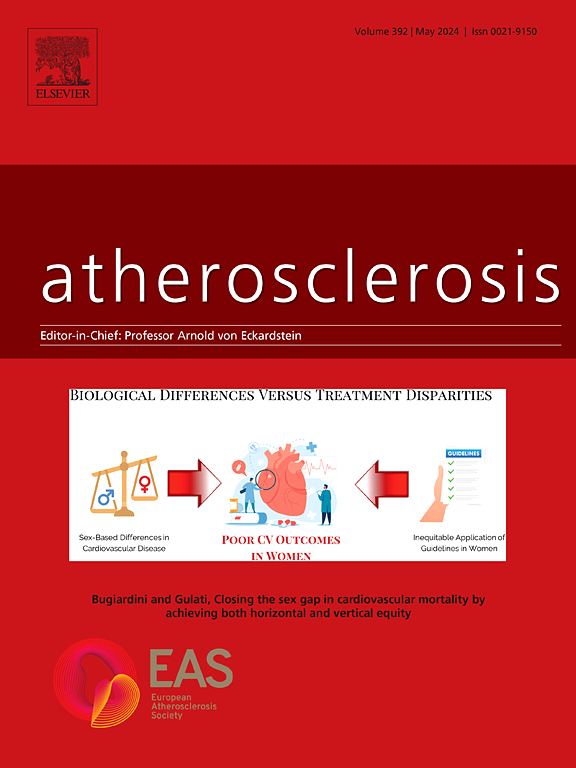Expression of the lymphangiogenic reelin is associated with sex-dependent calcific aortic stenosis in men
IF 4.9
2区 医学
Q1 CARDIAC & CARDIOVASCULAR SYSTEMS
引用次数: 0
Abstract
Background and aims
Aortic stenosis is a major form of adult valvulopathy with strong sex-related phenotypes. Circulating reelin, a large extracellular glycoprotein, regulates lymphangiogenesis and inflammation and promotes atherosclerosis, a risk factor in aortic stenosis. We sought to investigate the sex-dependent expression of reelin in stenotic aortic valves to comprehend its role in aortic stenosis progression.
Methods
Reelin was studied in aortic valves and serum samples from severe aortic stenosis and aortic regurgitation patients. In vitro calcification modelling of human valve interstitial cells (VICs) (n = 18 donors, 50 % men) was conducted for 2, 4 and 8 days.
Results
Reelin (RELN) expression was enhanced within the fibrocalcific areas of stenotic aortic valves, especially in men. Expression of RELN was associated with angiogenic and lymphangiogenic, inflammation and osteogenic markers only in aortic stenosis but not in aortic regurgitation. The VIC, along with inflammatory cells and valve endothelial cells, expressed reelin. In vitro, we confirmed the VIC to display sex-dependent responses as those reported within the valve. Male VICs expressed higher RELN than women's, and that was significantly associated with enhanced Dab2/Akt/NFkB signaling as well as with lymphangiogenesis, inflammation, and osteogenesis markers.
Conclusions
This study suggests a sex-dependent expression of reelin in stenotic aortic valves. This observation is partly due to different responses in VIC between men and women. In men, reelin was associated with inflammation, angiogenesis, lymphangiogenesis, and osteogenesis, which contributes to more calcific phenotypes, clinically relevant in male patients. However, further mechanistic studies are necessary to fully understand these processes. It's important to note that these findings were not reflected in circulating levels of reelin.

在男性中,淋巴管生成reelin的表达与性别依赖性钙化主动脉狭窄有关
背景和目的主动脉瓣狭窄是成人瓣膜病变的主要形式,具有强烈的性别相关表型。循环reelin是一种大的细胞外糖蛋白,调节淋巴管生成和炎症,促进动脉粥样硬化,这是主动脉狭窄的一个危险因素。我们试图研究reelin在狭窄主动脉瓣中的性别依赖性表达,以了解其在主动脉狭窄进展中的作用。方法对重度主动脉瓣狭窄和主动脉反流患者的主动脉瓣和血清样本进行reelin的研究。人瓣膜间质细胞(VICs)体外钙化模型(18例,男性50%)进行2、4和8 d。结果reelin (RELN)在狭窄主动脉瓣纤维钙化区表达增强,男性表现更为明显。RELN的表达与血管生成、淋巴管生成、炎症和成骨标志物相关,仅与主动脉狭窄相关,与主动脉反流无关。VIC、炎症细胞和瓣膜内皮细胞表达reelin。在体外,我们证实VIC显示出与瓣膜内报告的性别依赖性反应。男性vic的RELN表达高于女性,这与增强的Dab2/Akt/NFkB信号以及淋巴管生成、炎症和成骨标志物显著相关。结论本研究提示reelin在狭窄型主动脉瓣中存在性别依赖性表达。这一观察结果部分是由于男性和女性对VIC的反应不同。在男性中,reelin与炎症、血管生成、淋巴管生成和成骨相关,这导致了更多的钙化表型,与男性患者临床相关。然而,进一步的机制研究是必要的,以充分了解这些过程。值得注意的是,这些发现并没有反映在循环中的鱼鳞鱼水平上。
本文章由计算机程序翻译,如有差异,请以英文原文为准。
求助全文
约1分钟内获得全文
求助全文
来源期刊

Atherosclerosis
医学-外周血管病
CiteScore
9.80
自引率
3.80%
发文量
1269
审稿时长
36 days
期刊介绍:
Atherosclerosis has an open access mirror journal Atherosclerosis: X, sharing the same aims and scope, editorial team, submission system and rigorous peer review.
Atherosclerosis brings together, from all sources, papers concerned with investigation on atherosclerosis, its risk factors and clinical manifestations. Atherosclerosis covers basic and translational, clinical and population research approaches to arterial and vascular biology and disease, as well as their risk factors including: disturbances of lipid and lipoprotein metabolism, diabetes and hypertension, thrombosis, and inflammation. The Editors are interested in original or review papers dealing with the pathogenesis, environmental, genetic and epigenetic basis, diagnosis or treatment of atherosclerosis and related diseases as well as their risk factors.
 求助内容:
求助内容: 应助结果提醒方式:
应助结果提醒方式:


